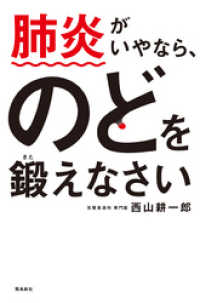- ホーム
- > 洋書
- > ドイツ書
- > Mathematics, Sciences & Technology
- > Physics and Astronomy
- > general surveys & lexicons
Description
(Text)
Electronics is the most important tool in nuclear radiation metrology. Without electronic instruments most of the problems concerned with measurement in pure or applied nuclear research, radiation protection or the use of radioactive isotopes in industrial process control would remain unsolved. Conversely, the radiation metrology was one of the first areas, if not the first, outside communications in which electronic devices were successfully employed. The quantum nature of nuclear radiations deter mined the need to work with pulse-type signals and thus contributed substantially to the establishment of analog and digital pulse techniques in electronics. It was no coincidence that, as late as 1949, W. C. ELMORE and M. SANDS were able to call the first monograph on nuclear electronics quite simply "Electronics". Despite these close interrelations between electronics and radiation measurement in nuclear physics, there is virtually no modern monograph dealing with the specialized electronic circuits and instruments used in measuring nuclear radiation. ELMORE and SANDS has long since become obsolete and, similarly, the excellent works covering special areas of nuclear electronics (e. g. A. B. GILLESPIE'S "Signal, Noise and Resolution in Nuclear Counter Amplifiers", 1953; I. A. D. LEWIS and F. H. WELLS' "Millimicrosecond Pulse Techniques", 1959; or R. L. CHASE'S "Nuclear Pulse Spectrometry", 1961) now lag well behind the latest advances in technology ).
(Table of content)
1. Introduction.- 2. Radiation Detectors and Related Circuits.- 2.1. Ionization Chamber.- 2.2. Proportional Counters.- 2.3. Geiger-Müller-Counters.- 2.4. Semiconductor Detectors.- 2.5. Scintillation and ?erenkov Counters.- 3. Analog Circuits.- 3.1. Linear Pulse Amplifiers.- 3.2. Arithmetic Operations on Analog Signals.- 3.3. Window Amplifiers.- 3.4. Linear Gates.- 3.5. Pulse Stretchers.- 3.6. Fast Pulse Amplifiers.- 4. Analog-to-Digital Converters.- 4.1. Pulse Height Discriminators.- 4.2. Digital Encoding of the Pulse Height.- 4.3.Pulse Shape Discriminators.- 5. Evaluation of the Time Information.- 5.1. General Considerations, Resolution.- 5.2. Pulse Shapers for Coincidence Circuits and Time-to-Digital Converters.- 5.3. Coincidence Circuits.- 5.4. Digital Encoding of the Time Interval.- 5.5. Auxiliary Circuits.- 6. Digital Circuits.- 6.1. Basic Digital Circuits.- 6.2. Scalers and Registers.- 6.3. Logical and Arithmetical Digital Circuits.- 6.4. Memories.- 6.5. Data Output.- 6.6. Count Rate Meters.- 7. Data Processing.- 7.1. Simple Counting Systems.- 7.2. Multiscaler Arrays.- 7.3. Multichannel Analyzers.- 7.4. Multiparameter Analyzers.- 7.5. On-Line Computers.- 8. Appendix.- 8.1. Laplace Transform Calculus.- 8.2. Noise.- 9. References.- 10. Subject Index.
Contents
1. Introduction.- 2. Radiation Detectors and Related Circuits.- 2.1. Ionization Chamber.- 2.2. Proportional Counters.- 2.3. Geiger-Müller-Counters.- 2.4. Semiconductor Detectors.- 2.5. Scintillation and ?erenkov Counters.- 3. Analog Circuits.- 3.1. Linear Pulse Amplifiers.- 3.2. Arithmetic Operations on Analog Signals.- 3.3. Window Amplifiers.- 3.4. Linear Gates.- 3.5. Pulse Stretchers.- 3.6. Fast Pulse Amplifiers.- 4. Analog-to-Digital Converters.- 4.1. Pulse Height Discriminators.- 4.2. Digital Encoding of the Pulse Height.- 4.3.Pulse Shape Discriminators.- 5. Evaluation of the Time Information.- 5.1. General Considerations, Resolution.- 5.2. Pulse Shapers for Coincidence Circuits and Time-to-Digital Converters.- 5.3. Coincidence Circuits.- 5.4. Digital Encoding of the Time Interval.- 5.5. Auxiliary Circuits.- 6. Digital Circuits.- 6.1. Basic Digital Circuits.- 6.2. Scalers and Registers.- 6.3. Logical and Arithmetical Digital Circuits.- 6.4. Memories.- 6.5. Data Output.- 6.6. Count Rate Meters.- 7. Data Processing.- 7.1. Simple Counting Systems.- 7.2. Multiscaler Arrays.- 7.3. Multichannel Analyzers.- 7.4. Multiparameter Analyzers.- 7.5. On-Line Computers.- 8. Appendix.- 8.1. Laplace Transform Calculus.- 8.2. Noise.- 9. References.- 10. Subject Index.








